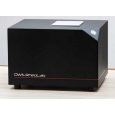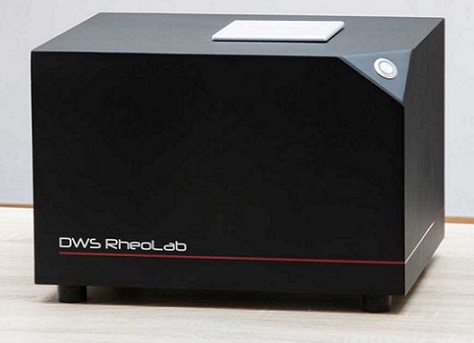
方案详情
文
利用扩散波谱技术对乳液进行测试。由扩散波光谱法微流变仪所得到的数值,具有很高的再现性,因而在与时间有关的特性研究上,例如乳胶的老化及稳定特性等,是非常有价值的工具。
方案详情

LSinstruments DWsRheoLab Emulsions measured by DWS Prepared by Mathias Reufer at LS Instruments AG, May 2013 Introduction Diffusing Wave Spectroscopy (DWS) is a powerful optical technique specificallysuited to study the rheological properties of turbid samples. The method is basedon the analysis of the fluctuations of coherent laser light that is scatteredmultiple times within a sample [1,2]. The DWS RheoLab from LS Instruments is aversatile tool to conduct such measurements. DWS requires well defined scattering objects embedded in the sample. They cannaturally be part of the sample or added for the purpose of enabling DWSmeasurements on otherwise transparent samples. In the latter case they aretermed tracer particles and are ideally monodisperse with high optical contrast.However, in emulsions such as lotions, creams, or milk the scattering objects areliquid droplets instead of solid particles, and the droplet size distribution ofemulsions often shows considerable polydispersity. The purpose of this application note is to demonstrate that emulsion droplets cannonethelessact: as natural tracersto probe theerheological properties ofemulsions using DWS. We apply this methodology to a model system which is a20 vol%oil-in-water emulsion with xanthan inn the continuous; phase asisaviscosity modifier. We furthermore compare measurements of the viscoelasticproperties of the emulsion obtained by DWS and mechanical rheology. Sample preparation The continuous phase is prepared by dissolving 0.55 wt% xanthan and 0.3 wt%Cosmocil as an antimicrobial agent in distilled water. This solution is heated for3 hours to 85°C to avoid sensitivity to thermal history [3] and subsequentlystirred for 48 hours. The emulsion is prepared by heating 164 g of the continuousphase to 50°C and adding 2.1 g Tween 80. During homogenization, 34 g ofalmond oil is added and then subsequently homogenized further for 12 minutes.All measurements are performed at a temperature of 25°C and 14 days afterpreparation of the samples. Characterization of the emulsion The emulsion is first investigated by confocal microscopy to access the dropletsize. Figure 1 shows an image of the emulsion stained with lipophilic Nile red. Theoil droplets are nicely dispersed and fully arrested in the xanthan matrix of thecontinuous phase. The inset shows the corresponding droplet size distribution. Figure 1 Confocal image of the emulsion stained with Nile red. Theinset shows the corresponding droplet size distribution. DWS on the emulsion isperformed in cuvettes withthicknessLL=2mmintransmission geometry. For calibration a dispersion of 1.0 wt% PS particles with980 nm in water is used. The measured value for the transport mean free path /*of the emulsion is 226 pm. For the tracer particle diameter we use a value of1.2 pm, which corresponds to the main peak in the inset of Figure 1. Mechanicalrheology is performed on a Malvern Bohlin Gemini rheometer equipped with sandblasted plane-cone geometry (60 mm, 2°) and solvent trap. The storage G'andloss moduli G" are measured in oscillation mode with constant amplitude of 0.1,which is found to be in the linear viscoelastic range by performing an amplitudesweep at 1 Hz. Figure 2 compares the values for G'and G"measured by DWS andmechanical rheology. In the overlapping frequency range the data sets show goodagreement. Figure 2 Storage modulus (full symbols, full line) and loss modulus (opensymbols, dashed line) of the emulsion. The data obtained from DWS (lines)agree well with the data obtained from the mechanical rheology (symbols). Continuous phase The prepared emulsion has a moderate volume fraction of the dispersed phase,therefore the rheological properties are mainly determined by the continuousphase. The continuous phase in our model system is a gel with 0.55 wt% xanthanand well known rheological properties [3,4]. We measure the continuous phase separately by DWS and mechanical rheology.For the mechanical rheology we use the same measurement parameters as formeasurements on the emulsion. DWS on the continuous phase is done on asample prepared byadding polystyrene (PS) particles with diameter 980 nm(dispersed in water) to a xanthan solution as prepared as above but with 0.58wt% xanthan. The resulting mixture contained 1.0 wt%o PS particles incontinuous phase with 0.3 wt% Cosmocil and 0.55 wt% xanthan. Thus, the PSparticles probe an environment corresponding to the continuous phase of theemulsion. DWS on the emulsion is performed in cuvettes with thickness L=2 mmin transmission geometry. For calibration a dispersion of 1.0 wt% PS particles with980 nm in water is used. The measured value for the transport mean free path /*of the emulsion is 398 pm. Figure 3 compares the values for G'and G"measured by DWS and mechanicalrheology. In the overlapping frequency range the data sets show excellentagreement. Moreover, the observed crossover frequency (where G'=G") of about10f rad/s is in very good agreement with literature [4]. Comparing Figure 2 andFigure 3, we find that the moduli of the emulsion are about 50% enhancedcompared to the continuous phase whereas the overall shape of the curves arevery similar. This confirms the hypothesis that for emulsions with moderatevolumefraction the rheological properties5 are mainly determinedl by tthecontinuous phase. In a crude approximation, the liquid droplets in an emulsion canbe interpreted as suspended solid particles that increase the overall viscosity nwith respect to the viscosity of the continuous phase no according to the Batchelorequation [5]: that yields for a volume fraction p=0.2 an increase in G"(w )= nw of 70%. Theobserved value of 50% is somewhat lower and might be explained by thepolydispersity of the droplets that allows better packing. Figure 3 Storage modulus (full symbols, full line) and loss modulus (opensymbols, dashed line) of the continuous phase only. The data obtainedfrom DWS (lines) agree well with the data obtained from the mechanicalrheology(symbols). LSinstruments Conclusion We applied DWS to an oil-in-water emulsion and compared tthe results tomechanical rheology. In the overlapping frequency range, very good agreementbetween the two techniques was found. Moreover, the continuous phase (xanthansolution) has been characterized separately by DWS and mechanical rheology andfound in excellent agreement with each other and also with literature. Thisdemonstrates that the droplets, i.e. the dispersed phase, can act as tracer particlesto probe the rheological properties of the emulsion. Moreover, provided the dropletsize isknown,Vwe showed that DWS microrheologyiswell suitedfor thequantitative characterization of emulsions. However, care must be taken when the continuous phase of an emulsion isinhomogeneous on the length scale of the droplets. In this case a quantitativecharacterization of emulsions is more difficult because the droplets probe a varietyof different local environments [6]. In the investigated model system this was notthe case since the mesh size of the xanthan network at the chosen concentration ison the order of 40 nm [4], thus well below the droplet size. Finally, the values measured by DWS are highly reproducible and might thus allowthe study of time dependent properties of emulsions such as aging or stability. References [1] D.A. Weitz and D.J. Pine; Diffusing Wave Spectroscopy in W. Brown, Dynamic LightScattering, Clarendon Press, (1993) [2] D. Lopez-Diaz and R. Castillo; Microrheology of solutions embedded with thread-likesupramolecular structures, Soft Matter 7, 5926-5937, (2011) [3] E. Choppe, F. Puaud, T. Nicolai, and L. Benyahia; Rheology of xanthan solutions as afunction of temperature, concentration and ionic strength, Carbohydrate Polymers82,(2010) [4] K.v Gruijthuijsen, H. Vishweshwara, R. Tuinier, P. Schurtenberger and A. Stradner;Origin of suprressed demixing in casein/xanthan-mixtures, Soft Matter 8, (2011) [5] S.R. Derkach;Rheology on the way from dilute to concentrated emulsions, Inter.Rev. Chem. Eng. 2, (2009) ( [6] F.K. Oppong, L . R ubatat, B . J. F risken, A .E. Bailey and J .R. de B ruyn; Microrheologyand structure of a yield-stress polymergel, Phys. Rev. E 73, (2006) ) T+ F+ info@lsinstruments.ch e www.lsinstruments.ch
确定
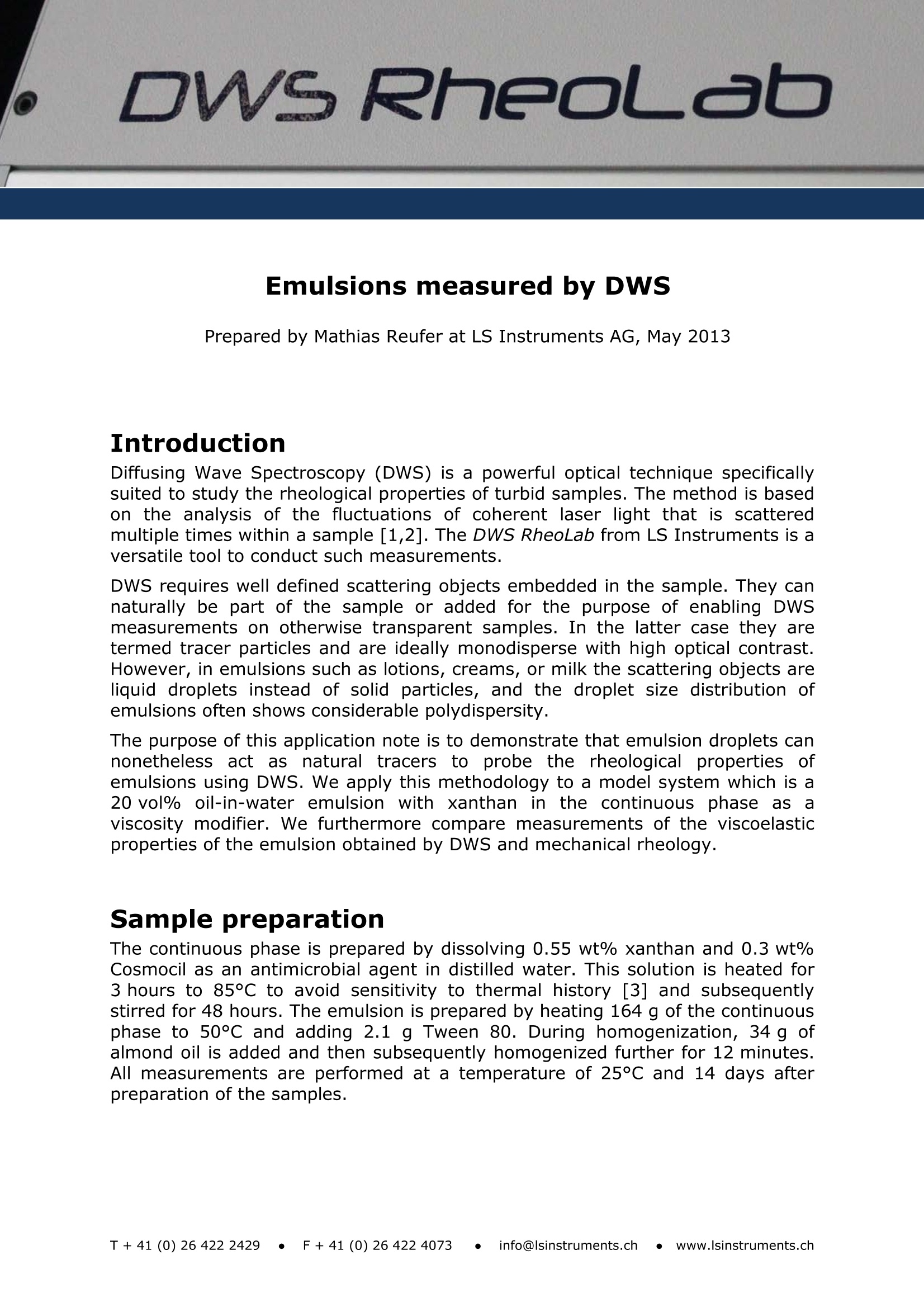

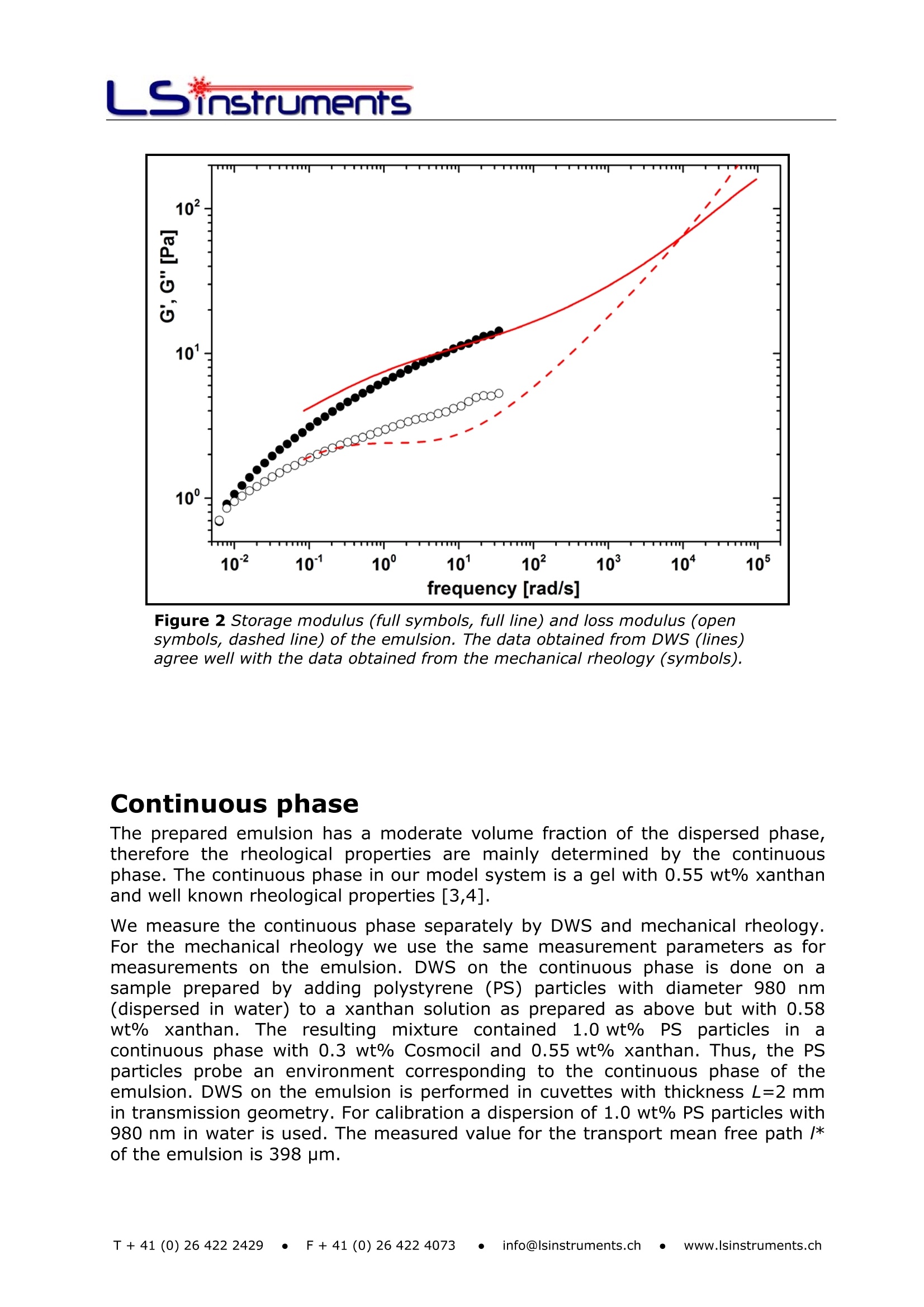
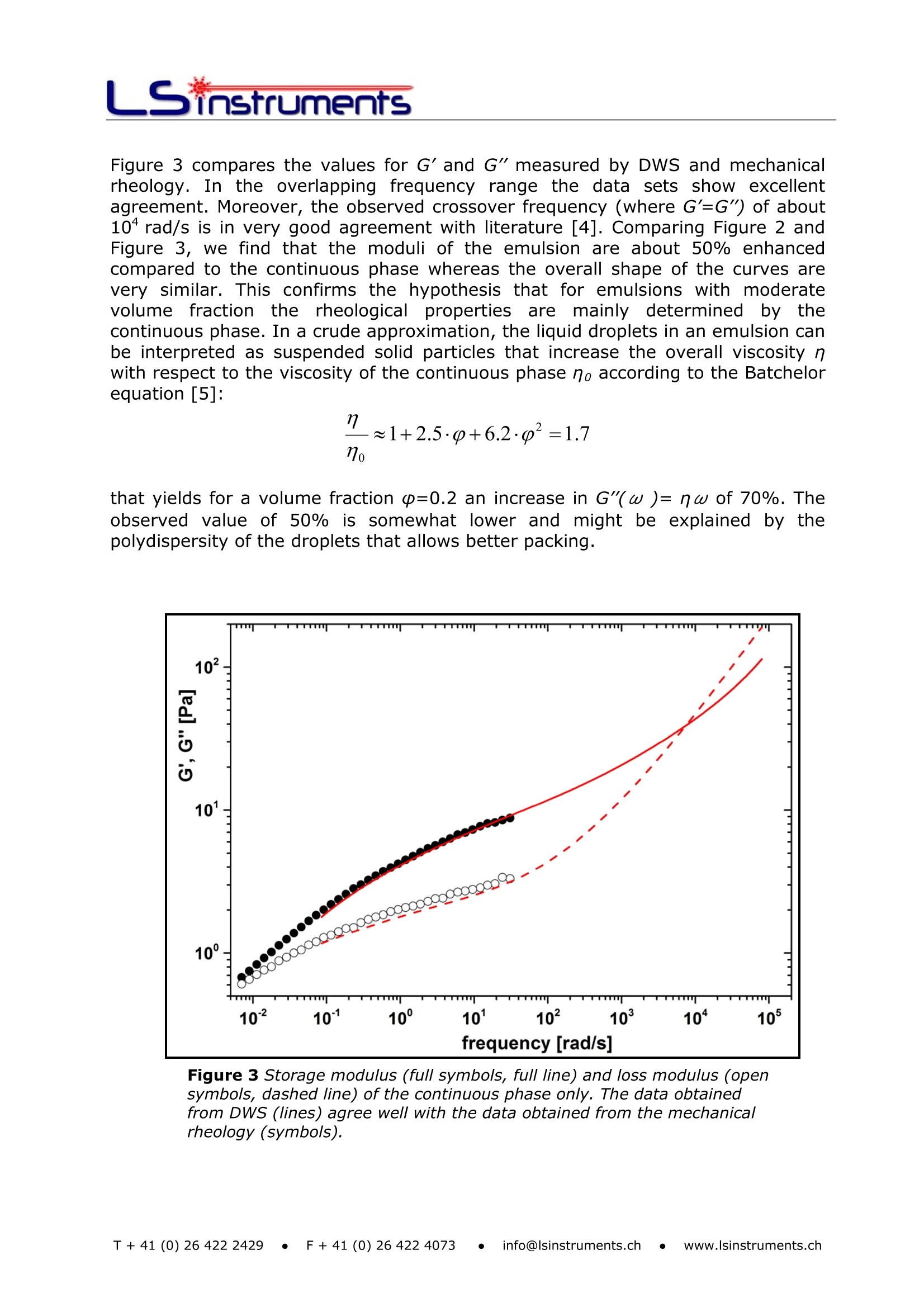
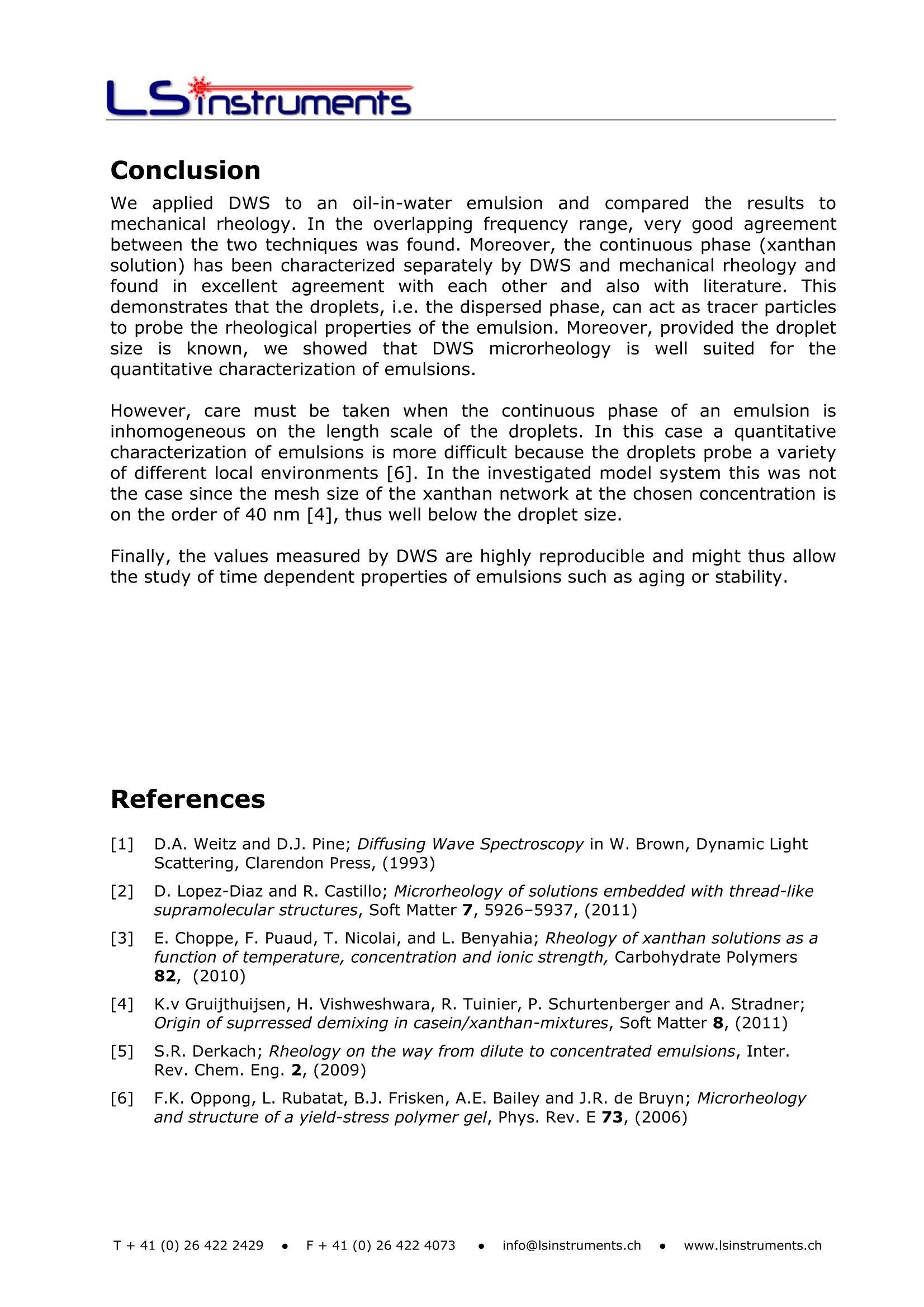
还剩3页未读,是否继续阅读?
北京赛普瑞生科技开发有限责任公司为您提供《扩散波谱仪在乳液中的应用》,该方案主要用于其他中--检测,参考标准--,《扩散波谱仪在乳液中的应用》用到的仪器有DWS RheoLab扩散波谱仪、DWS RheoLab扩散波谱仪
相关方案
更多
该厂商其他方案
更多










